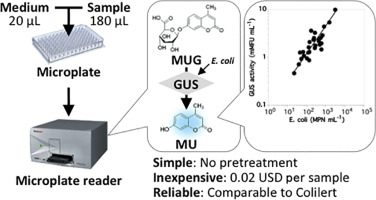当前位置:
X-MOL 学术
›
Sci. Total Environ.
›
论文详情
Our official English website, www.x-mol.net, welcomes your
feedback! (Note: you will need to create a separate account there.)
Simple and reliable enumeration of Escherichia coli concentrations in wastewater samples by measuring β-d-glucuronidase (GUS) activities via a microplate reader.
Science of the Total Environment ( IF 8.2 ) Pub Date : 2020-01-25 , DOI: 10.1016/j.scitotenv.2020.136928 Hisashi Satoh 1 , Kai Kikuchi 1 , Yutaka Katayose 1 , Shu Tsuda 1 , Reiko Hirano 2 , Yuga Hirakata 3 , Masaaki Kitajima 1 , Satoshi Ishii 4 , Mamoru Oshiki 5 , Masashi Hatamoto 3 , Masahiro Takahashi 1 , Satoshi Okabe 1
Science of the Total Environment ( IF 8.2 ) Pub Date : 2020-01-25 , DOI: 10.1016/j.scitotenv.2020.136928 Hisashi Satoh 1 , Kai Kikuchi 1 , Yutaka Katayose 1 , Shu Tsuda 1 , Reiko Hirano 2 , Yuga Hirakata 3 , Masaaki Kitajima 1 , Satoshi Ishii 4 , Mamoru Oshiki 5 , Masashi Hatamoto 3 , Masahiro Takahashi 1 , Satoshi Okabe 1
Affiliation

|
Monitoring of Escherichia coli concentrations at wastewater treatment plants (WWTPs) is important to ensure process performance and protect public health. However, conventional E. coli enumeration methods are complicated and time- and labor-consuming. Here, we report a novel simple and reliable method based on β-d-glucuronidase (GUS) activity assay to enumerate E. coli concentrations in wastewater (WW) samples. An aliquot (20 μL) of the medium with fluorogenic enzyme substrate for E. coli and 180 μL of a WW sample were added to one well of a 96-well microplate. The microplate was placed in a microplate reader at 37 °C. To this end, the fluorescence intensity of a fluorogenic enzyme substrate for E. coli was measured every 10 min over 3 h to determine GUS activity. The linear increase in the fluorescence intensity representing the GUS activities showed a positive correlation with E. coli concentrations in wastewater samples. However, the correlation equations were specific to WWTPs, which could be due to the difference in the E. coli population structures among WWTPs. We observed that the wastewater matrix is not a limitation to measure the GUS activity, and a WWTP-specific correlation equation can be used as a calibration curve to estimate the E. coli concentrations in the samples collected from that site. A comparison of the results with those of culture-dependent Colilert method proved that the current method is simple and useful for the enumeration of E. coli concentrations in wastewater samples reliably.
中文翻译:

通过酶标仪测量β-d-葡糖醛酸糖苷酶(GUS)的活性,可以简单,可靠地计算废水样品中的大肠杆菌浓度。
监测废水处理厂(WWTP)中大肠杆菌的浓度对于确保过程性能和保护公众健康非常重要。但是,常规的大肠杆菌计数方法复杂且费时费力。在这里,我们报告了一种基于β-d-葡萄糖醛酸酶(GUS)活性测定的新颖简单可靠的方法,可枚举废水(WW)样品中的大肠杆菌浓度。将等分试样(20μL)带有大肠杆菌荧光底物的培养基和180μLWW样品添加到96孔微孔板的一个孔中。将微板置于37℃的微板读取器中。为此,在3小时内每10分钟测量一次大肠杆菌的荧光酶底物的荧光强度,以确定GUS活性。代表GUS活性的荧光强度的线性增加与废水样品中的大肠杆菌浓度呈正相关。但是,相关方程特定于污水处理厂,这可能是由于污水处理厂之间的大肠杆菌种群结构不同所致。我们观察到废水基质不是测量GUS活性的限制,并且WWTP特定的相关方程可以用作校准曲线,以估计从该位置收集的样品中的大肠杆菌浓度。将结果与依赖于培养物的Colilert方法进行比较,结果表明,该方法简单易行,可用于可靠地枚举废水样品中的大肠杆菌浓度。相关方程是特定于污水处理厂的,这可能是由于污水处理厂之间大肠杆菌种群结构的差异。我们观察到废水基质不是测量GUS活性的限制,并且WWTP特定的相关方程可以用作校准曲线,以估计从该位置收集的样品中的大肠杆菌浓度。将结果与依赖于培养物的Colilert方法进行比较,结果表明,该方法简单易行,可用于可靠地枚举废水样品中的大肠杆菌浓度。相关方程是特定于污水处理厂的,这可能是由于污水处理厂之间大肠杆菌种群结构的差异。我们观察到废水基质不是测量GUS活性的限制,并且WWTP特定的相关方程可以用作校准曲线,以估计从该位置收集的样品中的大肠杆菌浓度。将结果与依赖于培养物的Colilert方法进行比较,结果表明,该方法简单易行,可用于可靠地枚举废水样品中的大肠杆菌浓度。WWTP特定的相关方程可以用作校准曲线,以估算从该站点收集的样品中的大肠杆菌浓度。将结果与依赖于培养物的Colilert方法进行比较,结果表明,该方法简单易行,可用于可靠地枚举废水样品中的大肠杆菌浓度。WWTP特定的相关方程可以用作校准曲线,以估算从该站点收集的样品中的大肠杆菌浓度。将结果与依赖于培养物的Colilert方法的结果进行比较,结果表明,该方法简单易行,可用于可靠地枚举废水样品中的大肠杆菌浓度。
更新日期:2020-01-26
中文翻译:

通过酶标仪测量β-d-葡糖醛酸糖苷酶(GUS)的活性,可以简单,可靠地计算废水样品中的大肠杆菌浓度。
监测废水处理厂(WWTP)中大肠杆菌的浓度对于确保过程性能和保护公众健康非常重要。但是,常规的大肠杆菌计数方法复杂且费时费力。在这里,我们报告了一种基于β-d-葡萄糖醛酸酶(GUS)活性测定的新颖简单可靠的方法,可枚举废水(WW)样品中的大肠杆菌浓度。将等分试样(20μL)带有大肠杆菌荧光底物的培养基和180μLWW样品添加到96孔微孔板的一个孔中。将微板置于37℃的微板读取器中。为此,在3小时内每10分钟测量一次大肠杆菌的荧光酶底物的荧光强度,以确定GUS活性。代表GUS活性的荧光强度的线性增加与废水样品中的大肠杆菌浓度呈正相关。但是,相关方程特定于污水处理厂,这可能是由于污水处理厂之间的大肠杆菌种群结构不同所致。我们观察到废水基质不是测量GUS活性的限制,并且WWTP特定的相关方程可以用作校准曲线,以估计从该位置收集的样品中的大肠杆菌浓度。将结果与依赖于培养物的Colilert方法进行比较,结果表明,该方法简单易行,可用于可靠地枚举废水样品中的大肠杆菌浓度。相关方程是特定于污水处理厂的,这可能是由于污水处理厂之间大肠杆菌种群结构的差异。我们观察到废水基质不是测量GUS活性的限制,并且WWTP特定的相关方程可以用作校准曲线,以估计从该位置收集的样品中的大肠杆菌浓度。将结果与依赖于培养物的Colilert方法进行比较,结果表明,该方法简单易行,可用于可靠地枚举废水样品中的大肠杆菌浓度。相关方程是特定于污水处理厂的,这可能是由于污水处理厂之间大肠杆菌种群结构的差异。我们观察到废水基质不是测量GUS活性的限制,并且WWTP特定的相关方程可以用作校准曲线,以估计从该位置收集的样品中的大肠杆菌浓度。将结果与依赖于培养物的Colilert方法进行比较,结果表明,该方法简单易行,可用于可靠地枚举废水样品中的大肠杆菌浓度。WWTP特定的相关方程可以用作校准曲线,以估算从该站点收集的样品中的大肠杆菌浓度。将结果与依赖于培养物的Colilert方法进行比较,结果表明,该方法简单易行,可用于可靠地枚举废水样品中的大肠杆菌浓度。WWTP特定的相关方程可以用作校准曲线,以估算从该站点收集的样品中的大肠杆菌浓度。将结果与依赖于培养物的Colilert方法的结果进行比较,结果表明,该方法简单易行,可用于可靠地枚举废水样品中的大肠杆菌浓度。











































 京公网安备 11010802027423号
京公网安备 11010802027423号